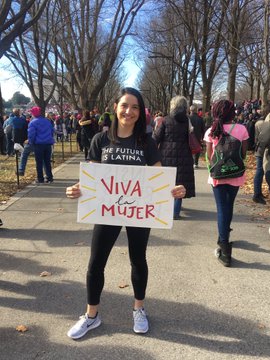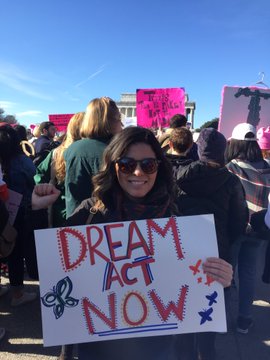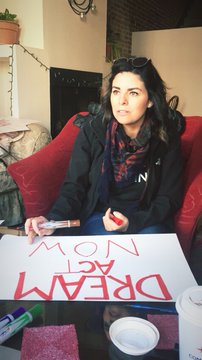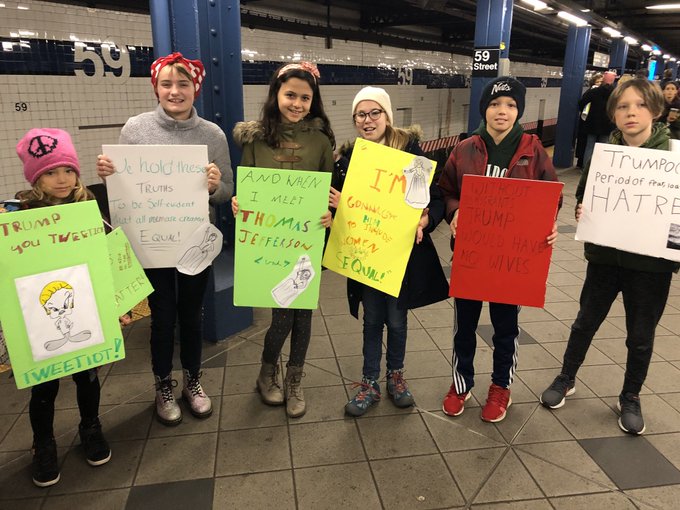#WomensMarch2018, reminding people that we need a #DreamActNow & that #TheFutureisLatina

Excerpt From ‘Beyond Charlottesville’: A 2019 Call To Action
In Beyond Charlottesville: Taking A Stand Against White Nationalism, former Virginia Governor Terry McAuliffe brings readers inside the tragic events of August 2017, which shattered America’s confidence in racial progress, exposed the raw aggression of white supremacy, and proved that the current president of the United States is on the wrong side. McAuliffe provides a fascinating minute-by-minute account of a government confronted by sinister violence — and in the epilogue that follows, he challenges every decent American with a call to action that we can ignore only at grave peril to our nation’s future.
Two years after Charlottesville, the blunt reality is we find ourselves in danger of not living up to the legacy of that tragic weekend in August 2017. Heather Heyer’s mother, Susan Bro, made the point at her daughter’s memorial service that the Nazi James Fields tried to silence her daughter with his act of terrorism, weaponizing his car against that crowd of peaceful protesters. “Well, guess what,” she said. “You just magnified her.” Susan urged everyone inspired by Heather’s death, whether they live in Charlottesville or another part of Virginia or anywhere around the world, to use it as an inspiration to get out there and work for change. “You make it happen,” she said. “You take that extra step. You find a way to make a difference in the world.”
Susan Bro handled the loss of her daughter with great dignity and grace. Since Heather’s death she has followed her own advice and gone to work, traveling the country to give talks urging people to get involved and actively work for change and social justice. Saying the right things isn’t enough. Action counts. As Robert F. Kennedy put it, “Progress is a nice word, but change is its motivator. And change has its enemies.”
When I talked recently to Susan Bro, looking back on Charlottesville after almost two years, she said she’d like to see more of a sense of urgency from more people. “Heather helped to open my eyes to a lot of things I’d been putting my head in the sand about,” Susan told me. “If after Charlottesville we just talk about ‘Love one another’ and have a kumbaya moment here, then we accomplish nothing, then we’re back to square one.”
Racism has been deeply ingrained in the fabric of our country throughout our history, and people have tried to shove it under the rug, again and again, citing progress. In Virginia, even with racist symbols all around, and some Virginia license plates still being issued with Confederate flags until I banned the practice, a jolt was needed to move us beyond the genteel sense of complacency. Charlottesville provided more than a jolt. It was a lightning bolt. Charlottesville lit up the scourge of racism and hatred of others as it really is, in the here and now. That spotlight offered an opportunity, but we have only a limited window to use that opportunity to leverage real change.
“If we don’t do it now, then we definitely wasted an opportunity—and wasted a life, frankly,” Susan told me. “That’s what I go around the country telling people.”
Then we wasted three lives, I’d say, including my friends Jay Cullen and Berke Bates. But this is larger than three lives and all the lives they touched. This is about all of us, who we are, how we live, and what we tolerate and don’t tolerate. This is about what we demand and don’t demand, of ourselves and others.
“The focus on Heather has tended to put a white savior complex yet again on black issues,” Susan told me. “I’ve had to be very adamant about pulling back on that and saying, ‘No, Heather is just a small part of the story.’ This was an awakening for a lot of white people, but black people were already quite well aware of the hateful agendas of some of the hate groups.”
That’s a point I heard from every African American I talked to about Charlottesville.
“White people are now getting the opportunity to see that we are not a post-racial society, just because President Obama was elected, and this is not just about Trump,” Charlottesville City Council member Wes Bellamy told me. “There are a lot of people who practice both covert and overt racism. So what do we do? Do we change policies? Do white people lend their voice as well as their privilege to be able to help out those who are disenfranchised? I think we can do that. . . . A lot of people could take a cue from Governor McAuliffe. He hired the first black secretary of the commonwealth. He restored voting rights. He took action and worked for equality. That’s how you use your privilege. That’s what you do.”
Levar Stoney thinks that after Charlottesville, there is no going back on issues of race. “You know from the history of Virginia that we’ve been very genteel in our treatment of racism,” he said. “We’re very passive about it. Like: We’re not as bad as Alabama, we’re not as bad as Georgia, we’re not as bad as Mississippi. But it’s baked into our way of life. After Charlottesville, there’s an attitude that we’re not going to be genteel, we’re not going to be passive. We need to be active, not just in dismantling the symbols of racism, but in how we remove inequality from our institutions like education and housing to build a more just and equitable society.”
I was frustrated during my time as governor at how much time gets wasted by people who should be working for real change. People love to play small ball. They get caught up in things that just don’t matter. I used to sit in my office with Jennie O’Holleran and my policy team, saying, “Honestly, are you serious? Why am I having to spend my time vetoing ridiculous bills passed by the Republican legislature that would allow guns into emergency shelters, or prevent a baker from selling a cake to a gay couple?” That shocked me. I think back now on all the time that was wasted, and all the work we have to do, but we can never make real progress until a full sense of urgency kicks in.
“White people don’t get it,” Larry Sabato says. “We don’t feel the sting of racism and don’t have the history of insult and hurt that African Americans have. Until whites do get it, progress is going to be limited. We’ll never make lasting progress if we pre-tend race isn’t still central to many of the problems that bedevil us. Maybe Charlottesville was the shock to the system we all needed to jumpstart real dialogue. Charlottesville ended the myth, or the dream, that racial reconciliation had mainly happened. Race is still a sore subject even in liberal communities like Charlottesville. In America as a whole, racism is woven into the very fabric of our institutions and our economy.”
Really, in the end it doesn’t matter who was surprised to see such raw racism and hatred on proud display in the streets of Charlottesville that weekend, it matters what we do. Virginia has made progress, but we have a long way to go. Why does Virginia have 378 monuments to the Civil War? Quit worrying about the cost. The cost to society of not removing them is much greater. We’re bold and brave enough to get it done. It’s time to take action. We have to start by giving local authorities decision-making power over what to do with their monuments and clear the way for action. The bottom line is: Those monuments are just offensive, and there is plenty of room to put them in museums and cemeteries.
“I think that what happened in Charlottesville has really been a catalyst in ways,” A. C. Thompson told me. “It was a catalyst for the white supremacist movement to collapse on itself, and a catalyst for Americans to realize they need to be aware of these issues.
A lot of folks knew there were aggressive racists in their community and they didn’t say anything about it or do anything about it. Afterward they did speak up, sometimes against people in their family. It activated people in the workplace. It activated people on the campuses. It activated people in politics. It activated law enforcement. I think there are a lot of actions that have sprung from the awful tragedy in Charlottesville.”
In some ways Donald Trump has served as an excuse. Having so unfit a figure in the White House has tied us all up in knots, fixated on his latest antics or tweets, his latest self-serving insults or distractions, his latest failure to see beyond his narrow self-interest or that of his family. Everyone gets so riled up all the time talking Trump this, and Trump that; it can be paralyzing for many. Trump is only a part of the bigger problem. Having him out of the White House will be a start—but only a start.
As Congressman John Lewis told me, “It’s not enough, but it will be a down payment on moving toward enough. I just think that he’s made the country so much worse off when it comes to the issue of building a community, of building a nation that is free. I thought we were on our way down that road, but every now and then there’s some force that comes along and arrests that progress.” Visiting John Lewis to talk about Charlottesville, two years later, was a very special moment. His wisdom moved me and I’m very thankful to him for the powerful foreword he wrote to this book.
Talking to John Lewis is like walking through living history—and that was especially true that day. By chance Robert F. Kennedy Jr. stopped by for a picture; he insisted on a photo with the three of us, and it was amazing to step into Congressman Lewis’s office. The walls were covered with incredible pictures cataloguing a remarkable life, but there was only one bust in that room: a bust of Robert F. Kennedy, attorney general in his brother Jack Kennedy’s administration, fierce fighter for civil rights, father of the man standing next to me. Bobby Kennedy stood for eloquence backed up by action.
“Each time a man stands up for an ideal, or acts to improve the lot of others, or strikes out against injustice, he sends forth a tiny ripple of hope, and crossing each other from a million different centers of energy and daring, those ripples build a current that can sweep down the mightiest walls of oppression and resistance.” Bobby Kennedy was a fighter. John Lewis is a fighter. I’m a fighter. You have to be a fighter and also work for social change. I’m proud of the work we all did in Virginia, starting with restoring the voting rights of all those individuals who had served their time and paid their debt to society and deserved to feel like full citizens again. I’m proud of moving the commonwealth of Virginia for- ward, socially and economically, of sending the signal to the world that Virginia is for lovers, we’re an open and welcoming state with a twenty-first-century economy and a vision of the future.
Our work during my time as governor was a start, but only a start—and we’ve all been reminded since then how fleeting progress can be. African Americans find blackface to be disgusting and insulting, and they’re right. It was a painful episode when the Virginia governor and attorney general were both embroiled in blackface scandals, especially after we’d spent four years moving Virginia forward. “It makes me sad,” John Lewis told me. “I know some people say, ‘Well, it was another time, another period, another day, they were much younger.’ But we cannot continue. We’re in a different world.” Every day we were focused on blackface in Virginia, we were distracted from the work at hand. As John Lewis says, progress was arrested. We have too much work to do to let ourselves be slowed down. We have too many challenges that demand immediate action, from improving the educational opportunities of every young person in this country to generating the good-paying jobs that are the ultimate answer to economic inequality; from helping displaced workers retrain for the twenty-first-century economy to expanding Medicaid and continuing in the decades-long struggle to improve health care in this country. We need fresh energy, not distractions, which is why I’m so excited to see so much engagement among the young and so many smart, dynamic, qualified younger people getting into politics and nonprofit work in a variety of roles.
To bring more people into politics, we have to reach out to them, especially in less affluent communities. The young can’t be inspired, and inspire us in turn, if no one gives them a chance. As Lamont Bagby told me: “Those individuals need resources. They need to be able to come down and see the Virginia House of Delegates in action. They need to go to Washington, DC, and see people in action. They just need to be inspired. They inspire us; we need to make sure that they know the opportunities that are before them.”
Until every American and every elected official gets out of bed every single day fighting for social justice and equal opportunity, we are failing as a society. Until we get there, it’s all just talk. We have to do a better job at home and in our schools, teaching respect and valuing differences and not sugar-coating the past as heritage rather than inherited racism. We have to take away the barriers to success that affect so many in our communities of color. We have to tackle lack of access to quality health care, mass incarceration, disproportionate prison sentencing and mandatory minimums, and the “lock ’em up” mentality. We’ve got too many African American students going to dilapidated schools with the roofs falling apart. The issues that Barbara Johns fought for in 1951 are still all too prevalent. Infant mortality rates in African American communities, like Milwaukee, are a scandal. We have to get out of the past and move to the future.
“We have to fix the systems that cause the divide,” Susan Bro told me. “We have to fix the inequities, or we’re going to end up right back in the same place. In education, housing, business loans, we have to undo the wrongs of the past. Somebody might say they want to undo all that, but are they willing to put their kids in a public school? Or are they only willing to say they want to be a part of the process, but only from the outside?”
The truth was revealed in Charlottesville. We are a divided nation today, stuck in the past, racism still rampant. “As bad as it might have been, it was under wraps until Donald Trump got elected,” Virginia state senator Louise Lucas, who represents Portsmouth, told me. “He tore the lid off of the reservations people had about being open about it.”
Lucas, who was born in 1944, also said, “I have not seen so much hate and vitriol in my adult life. I haven’t seen so much since the early days of the Civil Rights Movement.”
Young people were the key to change then and they can be the key now, she believes.
“We have to stay in the trenches with them, making them feel they are part of the process,” she said. “We have to make sure that their active minds have something to think about and their busy hands have something to do. We have to keep them engaged to let them know there is hope, everybody working together, Generation X and Millennials and all generations.
If you were offended, disgusted, and outraged by what happened in Charlottesville, good! Then it’s your responsibility to do something about it. Up until Trump, and up until Charlottesville, race was something that, too often, people didn’t want to talk about. There was a notion kicking around that we’d corrected the problem. That was false. People felt too comfortable in their insular little worlds.
My message to everybody is: Stop being comfortable. Stop believing we’ve come so far. As Charlottesville has proven, we haven’t. I’d like to thank all the peaceful protesters who came out in Charlottesville to oppose hate. That wasn’t comfortable. You won’t feel comfortable when you’re out there working for change.
You won’t feel comfortable taking on hatred and bigotry. Forget reconciliation commissions. Words, words, words. It’s a bunch of white people sitting around together trying to feel comfortable to talk a problem to death, but it doesn’t bring change. Action brings change. Do something. Do it now.








